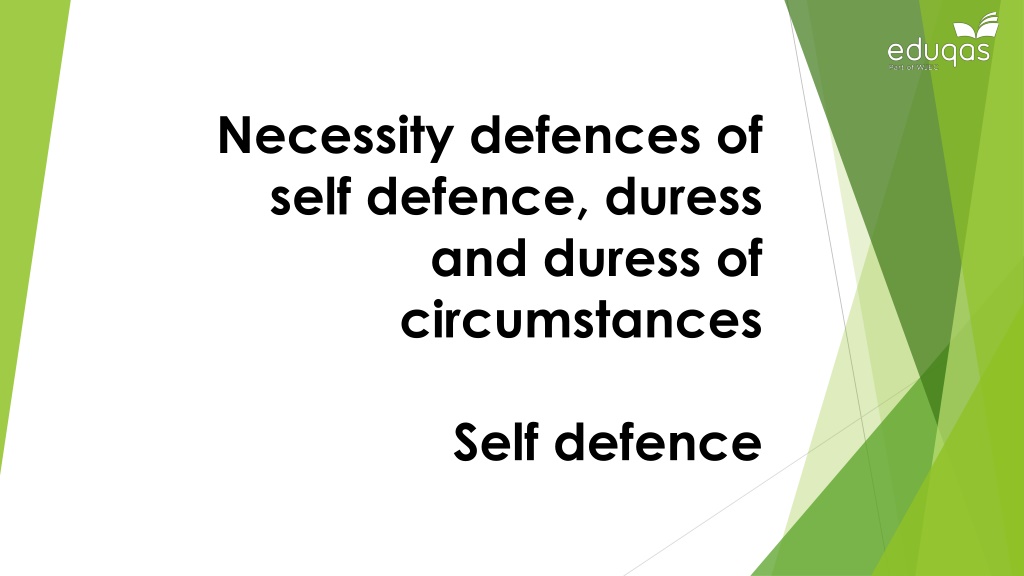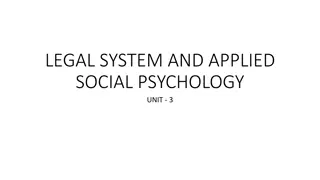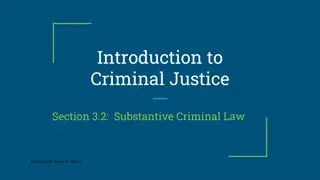Self-Defence in Criminal Law
Self-defence is a crucial aspect of criminal law, encompassing actions taken to defend oneself or others from harm. This defense allows the use of reasonable force in specific circumstances, both under common law and statutory provisions. The concept of self-defence is further clarified by relevant legal statutes and case examples, highlighting the nuances and limitations of this defense in various situations.
Download Presentation

Please find below an Image/Link to download the presentation.
The content on the website is provided AS IS for your information and personal use only. It may not be sold, licensed, or shared on other websites without obtaining consent from the author.If you encounter any issues during the download, it is possible that the publisher has removed the file from their server.
You are allowed to download the files provided on this website for personal or commercial use, subject to the condition that they are used lawfully. All files are the property of their respective owners.
The content on the website is provided AS IS for your information and personal use only. It may not be sold, licensed, or shared on other websites without obtaining consent from the author.
E N D
Presentation Transcript
Necessity defences of self defence, duress and duress of circumstances Self defence
Self defence This defence not only covers actions needed to defend oneself from an attack, but also actions taken to defend another. The defences of self-defence and defence of another are common law defences, in addition there is also a statutory defence.
Self defence Criminal Law Act 1967 Section 3 Statutory defence: A person may use such force as is reasonable in the circumstances in the prevention of crime or in assisting in the lawful arrest of offenders or suspected offenders, or of persons unlawfully at large .
Self defence The amount of force that can be used in self-defence, defence of another or in the prevention of crime is set out in s.76 of the Criminal Justice and Immigration Act 2008. In deciding whether the force used is reasonable in the circumstances : a) That a person acting for a legitimate purpose may not be able to weigh to a nicety the exact measure of necessary action; and b) That evidence of a person s having only done what the person honestly and instinctively thought was necessary for a legitimate purpose constitutes strong evidence that only reasonable action was Taken by that person for that purpose
Self defence S.76 allows for a person who is facing an attack , is under stress and cannot be expected to work out the exact amount of force needed in the circumstances. If there is evidence that the person honestly and instinctively thought the level of force was reasonable to protect himself or another, or to prevent crime then this is strong evidence that the action taken was reasonable in the circumstances. However if the force is used after all danger is over (e.g. out of revenge or retaliation ) the defence is not available. Hussain and another (2010) the defendant s house was broken into and he and his family were threatened by armed men. The defendant and one of his sons managed to escape and chased the armed men as they ran from the house, they caught one of the men and beat him up. It was held that they could not use the defence of self-defence as all danger to them from the original attack was over.
Householder cases S.43 of the Crime and Courts Act 2013 has amended s.76 of the Criminal Justice and Immigration Act 2008 to allow for a wider defence to householders where an intruder enters their property. In such cases the degree of force will NOT be regarded as reasonable only where it was grossly disproportionate To be a householder case: The force must be used by the defendant while in or partly in a building that is dwelling. The defendant must not be a trespasser. The defendant must have believed the victim to be a trespasser.
Excessive force The amount of force used to defend oneself or another must be reasonable. If the force used is excessive the defence will fail. Clegg (1995) Clegg was a soldier on duty in Northern Ireland. A car came towards him at the checkpoint he was manning and sped with its headlights on full beam. One of the soldiers with Clegg shouted for the car to stop, it did not. Clegg fired 3 shots at the car and a further shot as the car passed him, the final shot hit and killed a passenger in the back of the car. Clegg could not use self-defence as a defence as evidence showed that the car had gone past him by the time he fired the last shot so there was no danger when he fired the shot the force was excessive and his murder conviction was upheld. In 1999 Clegg s case was sent back to the Court of Appeal by the CCRC his conviction was quashed as new evidence cast doubt as to whether Clegg actually fired the fatal shot.
Excessive force Another case concerning excessive force was Martin (Anthony) (2002) Martin shot two burglars who had broken into his remote farmhouse, killing one of them. Evidence showed that the burglars were leaving when Martin shot them, and that the one who had died had been shot in the back. Martin was found guilty of murder. He appealed arguing he should have been allowed to use the defence of self-defence as he was suffering from a paranoid personality disorder which made him think he was in a very dangerous situation. His appeal was rejected by the Court of Appeal, they held that personality disorders could not be taken into account when considering the defence of self- defence. His conviction was , however, reduced to manslaughter on the grounds of diminished responsibility.
Relevance of the defendant's characteristics As seen in Martin (2002). His appeal was rejected by the Court of Appeal, they held that personality disorders could not be taken into account when considering the defence of self- defence. The decision in Martin was followed in Cairns (2005) where the court held that when deciding whether the defendant had used reasonable force in self-defence, it was not appropriate to take into account whether the defendant was suffering from a psychiatric condition. The law in Martin and Cairns was upheld in Oye (2013).
Had the Defendant made a Mistake? Williams (Gladstone) (1987) Defendant had to have a genuine mistaken belief which may or may not be reasonable. Defendant witnessed what he thought was a fight and tried to intervene saying he was a police officer and trying to make an arrest. In fact one of the people involved had just mugged a woman and the other was trying to arrest him! The Defendant was prosecuted for assaulting the victim but the jury was told he could only use mistake if it was reasonable. On appeal the court said that the jury should have been told that if they believed it was a genuine mistake they should decide the case on this basis and Williams was able to use the defence of protection of others.
Problems with self-defence It s an all or nothing defence. This makes the mandatory sentence for murder very harsh - but with other offences it will be considered as a mitigating factor.























